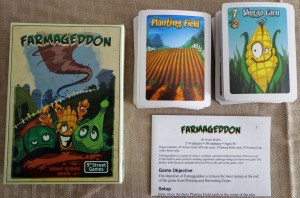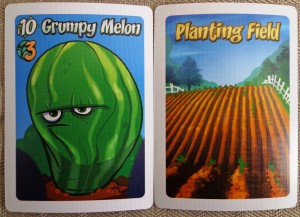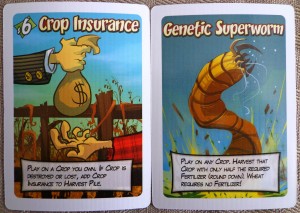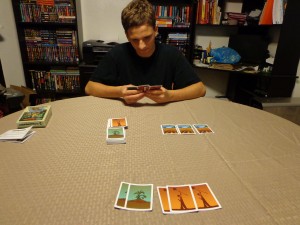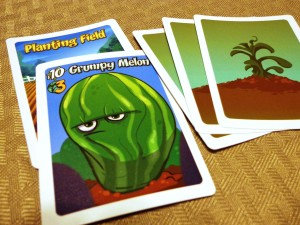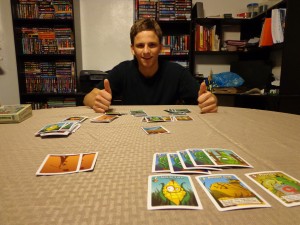There’s nothing like the taste of corn on the cob that’s been buttered and salted to perfection…but how did such a wonderful creation come to be? Despite popular belief, it is not because a mommy corn and a daddy corn loved each other very much, rather, corn is grown and harvested through a process we call farming. Pay attention kids, there will be a quiz later…
Farmageddon is a card game that tasks players with harvesting crops for victory points. Farmland is scarce, so there will be pushing, shoving, and some harsh words spoken (nothing higher than PG, of course). Before we get started, I’d like to thank both Phil Kilcrease (publisher) for sending me a free review copy and Grant Rodiek (designer) for being kind enough to point me in Phil’s direction.
Components
Cards – There are Action cards, Crop cards, and Field cards. Action cards allow players to take special actions during the game that either help themselves or set back their fellow farmers. Crop cards, when played face up, are placed on one of the three field cards to begin the planting process. Crop cards can be played face down on top of an existing face up crop card, in which case they act as fertilizer.
Note: There are 10 crop cards with “FC!” (FrankenCrops) on the bottom of the card. They are special crops that have special abilities listed on their card face. During the game setup, these cards can be either removed from the game or included in the crop deck…players are encouraged to remove them for their first game so that they can get the basics down.
Setup & Gameplay
The crop and action cards are shuffled separately and the three field cards are placed between all players. Each person gets two crop cards and three action cards. The starting player is whoever visited a farm last, though I usually just let the youngest go first.
A player’s turn consists of the following:
1) Draw two crop cards (three in a two player game).
2) Take any actions they wish, which consist of:
Planting Crops – The player can place any number of crop cards face up on unused field cards (one crop per one open field). When fields are claimed in this way, the field is moved so that it sits in front of the player until the crop in question is harvested or destroyed.
Placing Fertilizer – The player can place any number of crop cards face down onto ANY field occupied by a crop to serve as fertilizer. If they are able to do so, the player must play at least one crop card as fertilizer on their turn (two in a two player game), even if it means placing it on an opponent’s field.
Playing Action Cards – The player can play up to two action cards and are discarded when used, except when otherwise indicated.
Harvesting Crops – When a crop card has enough fertilizer on it (as indicated by the crop card), it can be harvested. Players can only harvest crops on fields they own, and they can’t be harvested in the same turn that they are planted. Harvested crops go into a separate pile (the Harvest Pile) to be scored later. Field cards that become empty in this manner are put back into the center of the table.
3) Draw two action cards (one in a two player game).
The game continues in this fashion until the final crop card is drawn from the deck. Every player except the one who drew that crop card gets to take one last turn. After that, any fully fertilized crops are awarded to players automatically and scores are tallied. Whoever has the most points in their harvest pile wins!
The above is just an overview of the gameplay mechanics, but should still give you an idea of how the game is played. To learn more, you can check out the manual here:
The Review
Let me start off by saying that the game was very easy to pick up and play. The learning curve was light and it took maybe ten minutes for me to explain the rules to kids, if that. The game can also be played fairly quickly, our games lasting no longer than a half hour. As such, this game would definitely be suitable for younger kids. How young is definitely up to the parents, but I could see a gifted six or seven-year old being able to play the game, provided that the parents coach them and have the patience to do so.
For as simple as the gameplay mechanics are however, the game does give players a few choices on their turn. What actions players take on their turn and in what order they take them can make a difference in their final score. While it might seem like excellent card management might allow a player to keep fields in front of them most of the time, the action cards are varied enough to help prevent this.
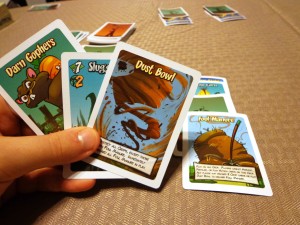
Anthony played a manure card on my crop, which prevents me from placing fertilizer on it and harvesting it. Luckily, the dust bowl card will not only destroy the manure, but Anthony’s crops.
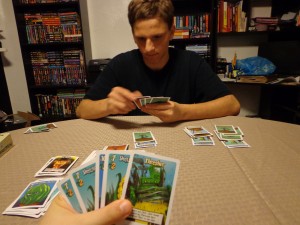
Anthony has all three fields under his control. Luckily, I can play a thresher card to destroy one of his crops, and then plant a crop on the empty field to claim as my own.
There’s still a bit of luck involved in drawing the right action cards for the right circumstances, but not having a hand limit will assist players in saving particular action cards for when they really need them. There’s also some strategy in choosing easy to grow crops over hard to grow crops…the longer players leave crops in their fields, the stronger the chance that someone might throw a wrench into their best laid plans. I also appreciate the “must play x number of crop cards as fertilizer per turn” rule, as it prevents players from hoarding crop cards to play all of them at once at the right moment.
Vinnie (11) and I played a two player game and he seemed to enjoy himself. We both made the comment while playing that the art on the cards themselves were fun to look at and the text easy to understand. He didn’t need any coaching from me in developing his own strategies. He also mentioned that the game was “sort of like Nile DeLuxor” in that there was a harvest pile. I was glad to see him making these comparisons on his own and paying attention to the vast array of games that I have exposed him to over the last year.
Anthony (16) and I played a separate game which I found to be a lot more challenging. I could tell that he was trying very hard to maintain control over the three fields by playing his cards appropriately. We were both timing our harvests so that we could immediately reclaim those precious fields by planting a new crop on the same turn. There were times I could feel that timing was on my side and that I was in control (we chess players call it tempo) and there were other times where I hoped for an action card to turn the tides back into my favor.
Overall, Farmageddon is a great option for family game night. It’s easy to learn, which makes it a viable option for almost any age group. Its quick play time means that it can be played almost anywhere, whether it is at home at the dining room table or while on vacation. As a parent who enjoys gaming with the family, I recommend taking a look at this little gem.
Final Verdict: 8/10
You can learn more about “Farmageddon” by visiting the 5th Street Games website and BoardGameGeek, located here:
—

